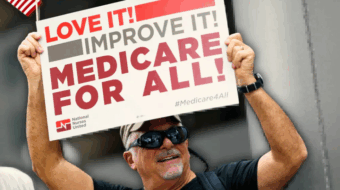I read too many analysts these days that say that the passage of real health care reform rests largely on President Obama’s shoulders.
They are right up to a point. The president has to make an even more forceful case for health care reform this fall in face of the stiff and entrenched opposition arrayed against it.
But missing in their analysis is any mention of the other major player on the people’s side of health care struggle – the people’s coalition that elected Barack Obama last year.
President Obama is a brilliant politician, but his election victory was as much the doing of the broad coalition that supported him, as it was his own brilliance. The alliance of candidate and coalition was mutually dependent, dynamic, and decisive in the end.
Moreover, this alliance (or more precisely, the continuation and extension of the Obama led election coalition) is necessary in the post-election period. It’s the material counterweight to right- wing extremism and its corporate allies, the strategic cornerstone for progressive and radical reforms going forward.
Separately, neither the president nor the people’s organizations have the muscle to make “justice roll down like a mighty stream.” But united, they pack a wallop!
Most advocates of progressive and radical change understand this well. The extreme right along with formidable sections of the corporate class, also get it and are doing everything they can to bust up this alliance.
With an African American in the White House, a Latina on the Supreme Court, the embedding of gay sensibilities in our culture, and an economy that is laying waste to the traditional role of the male breadwinner, right-wing extremists are issuing racist, misogynist, homophobic, and anti-government appeals to white people and especially white males. Limbaugh, Hannity, and other talk show hosts are howling to whoever will listen, “Take back America.”
Now you probably thinking that this is not a new phenomenon and you are right in that regard. But at the same time, it is reaching a higher decibel level, taking on even uglier forms, and evoking an extremely dangerous, even irrational, reaction from too many people.
I’m not suggesting that fascism is around the corner or that the majority of the American people embrace these backward sentiments. I could easily cite other trends and public expressions that go in the opposite direction, including the new level of anti-racist feeling that was evident in last year’s election – perhaps no more so than in the labor movement.
But what I am saying is that a progressive turn in our nation’s politics won’t be a cakewalk. Like every other period its outcome will not rest on one encounter; instead it will be the result of a contested, complex, and dialectical process, taking place on many levels and over time.
The main task now is to build the strategic alliance mentioned above. There will be, of course, tensions, contradictions, and competing views – not unexpected in an alliance with a diverse social composition and multiple ideological tendencies – not to mention contending with such a ferocious and clever opposition.
Even where agreement exists on programmatic direction, differences over priorities, pace, timing, and the character of the reform process will surface.
And yet, for anyone who desires a new burst of freedom, for anyone who yearns for a society deeply democratic and free of exploitation, there is no other alternative to the deepening and extension of this alliance at this stage of struggle. It’s the only way to higher ground.
All of us who want to live in a more just, peaceful, and equal society must master the art of fighting for unity while, at the same time, stretching the boundaries of the possible. It isn’t an easy needle to thread, but the struggle for freedom never is.










